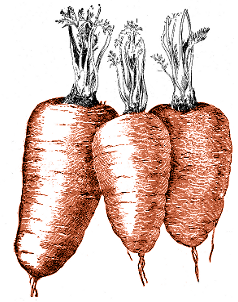Archive for the ‘The Old Garden In Bristol’ category
Posted in Garden Diary, The Old Garden In Bristol on Sunday, December 18th 2011 (8.28 PM).
The frost has really started to come in in the past week. I’m learning which parts of the garden are hit by it the hardest: the sheltered area between shed and house stays frost-free the longest, and the other side of the shed, where the bee house is, also seems to stay fairly sheltered. The middle of the garden, and the prime planting area, get hit the hardest, although so far this winter the perennial plants seem to be largely bearing up. Fingers crossed.
After I planted the garlic, three weeks ago, there were a few small cloves left over from the bulb. Today, I planted those up in the containers that, this year, we grew carrots in. The carrots – more of that free BBC seed – did not really grow very well, possibly because the containers are a little small. We will see how the garlic does: we’re starting, in these containers, with the least-viable-looking cloves already, so there won’t really be any scientific conclusions we can draw from it.
The three-weeks-planted garlic hasn’t appeared above the surface yet. K says I’m being silly, looking regularly, because at this time of year it won’t break the surface for months. But, still, I keep looking to see if sprouts have appeared.
carrot, frost, garlic, planting, weather, winter
Posted in Photobloggery, Practicalities, The Old Garden In Bristol on Sunday, December 11th 2011 (3.10 PM).
We missed harvesting the last green beans and runner beans this year, because we had a holiday planned. By the time we got home, they had gone past eating. Still, no point letting them go to waste, so we left the beans on the plant to develop and dry. That was the intention, at least: as the weather became wetter, it didn’t look like there was much chance of them drying successfully on the plant, so we picked them and popped them into a tub in the fridge – unsealed, but covered with kitchen roll. I gathered it would be a good drying-out spot for beans: cold, dark, and naturally drying. Now, a few weeks later, they are dry, hard, and ready to be popped into a storage tin. And they are beautiful: creamy-white green beans and rich, midnight blue and pink runner beans.
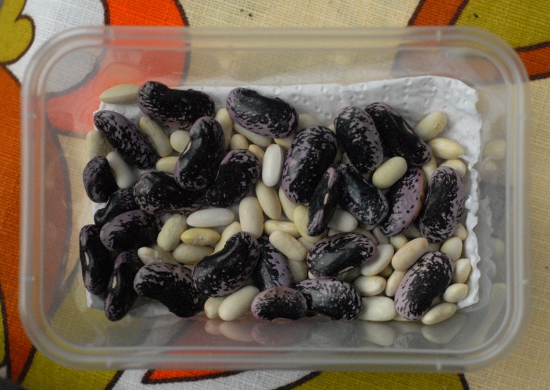
It is, really, the whole point of sustainable gardening. We are never going to be self-sufficient, with our little city plot, but equally we don’t want to be restocking our containers with freshly-grown garden centre seedlings each spring when we can raise our own instead. I don’t expect all of these seeds to be viable, but we don’t need many to be viable: this pot could fill our entire garden with beans if we wanted. This isn’t sophisticated breeding: the runner beans are from some spare plants a friend gave us, and the green beans are from some free seeds the BBC was giving out the other year, part of their Dig In project. Being beans, they might not even breed true, but hopefully next year’s bean supply is now in place.
bean, green bean, runner bean, saving seed, seed
Posted in Planning, Practicalities, The Old Garden In Bristol on Sunday, December 4th 2011 (10.12 PM).
In the news the other day: the ongoing drought is, well, ongoing; it will take an awful lot of rain just to get our aquifiers back to where they normally are by the end of winter.
Over in Bristol things aren’t as bad as they are further east: we have more rainfall over here than the rest of the country, or at least it always feels that way. Still, it makes me feel guilty about container gardening. It does need more water: containers are always drying out, and don’t catch as much rain as you might expect, especially in a sheltered garden with walls and fences on all sides. Our back bed, when we get it into use, will assuredly be always slightly too damp: it already tends to have a green scum quickly appearing on the surface of the soil, as if it were still in the Proterozoic eon.
What we should be doing, of course, is getting a butt set up. Indeed, if you scroll down or look back at the layout of our garden, you’ll see that we have a couple of potential butt-sites mapped out. One, by the door, would take up quite a bit of our main container-planting space. The other, in a corner between the shed and the house, would be a useful way to occupy an awkward spot; but the problem is getting the water to it. The former site is right by the downpipe, but the more useful site is a long way from the water supply. A pipe would have to be run across the back of the house – right across where the kitchen window is. The gutters are too low, really, to run a pipe across the top of the window, and a pipe underneath it would mean a rather short water butt.
The whole thing is a bit of a tricky problem. I know, conscientiously, we should be saving at least a portion of our rainwater, but finding the place to save it in is going to be a problem. Maybe we’re going to have to think of another way to do it, and work out a more radical answer.
butt, climate, rain, rainwater, water, water butt, weather
Posted in Garden Diary, Photobloggery, Practicalities, The Old Garden In Bristol on Sunday, November 27th 2011 (8.22 PM).
Today, we cut down the remaining wizened bean plants, having made sure we had saved all the potentially viable beans for sowing next spring. With the beans and their canes missing, the garden has lost all its height, and looks very empty all of a sudden. Very bare, compared to June or July.
However, the cycle goes around. In the post, the other day, a garlic bulb arrived.
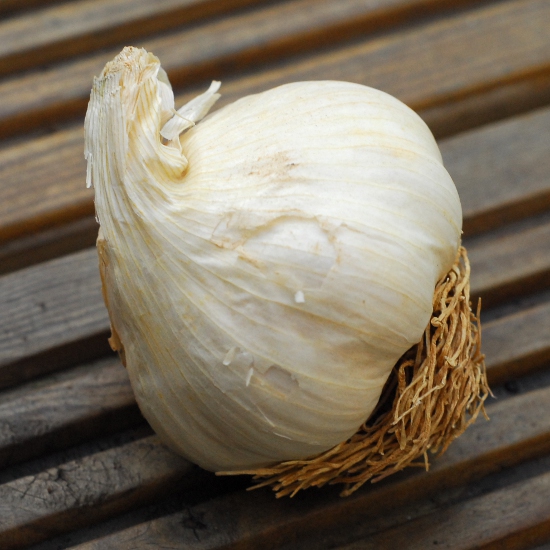
Carefully peeling off the papery skin revealed a tight-packed spiral of fat cloves.
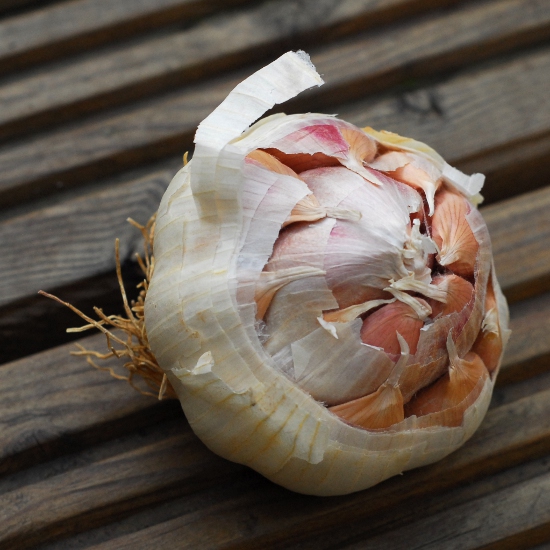
This is a softneck variety, Solent Wight, chosen because it’s meant to be a particularly easy variety to grow in southern England, as you might expect from the name. The cloves were planted up in a couple of our largest containers, moved to the sunniest side of the garden along the wall of the house; in spring a thin sprinkling of annual flower seeds might go in between the garlic stems if there looks to be enough space for them. In 8 or 9 months, if all goes well, this bulb will have turned into ten or more ready for drying and eating.
bean, garlic, green bean, planting, runner bean, solent wight, sowing
Posted in Decorative, Photobloggery, The Old Garden In Bristol on Friday, November 18th 2011 (6.38 PM).
There haven’t, as you might have noticed, been that many posts on here in recent weeks. One reason for that, more than anything else, is the changing of the season and the changing of the timezone. When I get up in the morning, it’s dark. When I leave the house, it’s just about light – at the moment it will have been light for maybe 15 minutes, which of course will drop over the next 6 weeks. When I get home again, it’s dark, and it’s been solidly dark for well over an hour. Getting a job nearer home would help, but probably not very much, especially in the evenings.
However, there is one benefit to all this darkness. It means we can string solar-powered fairy lights all around the garden, and actually have darkness to see them in.
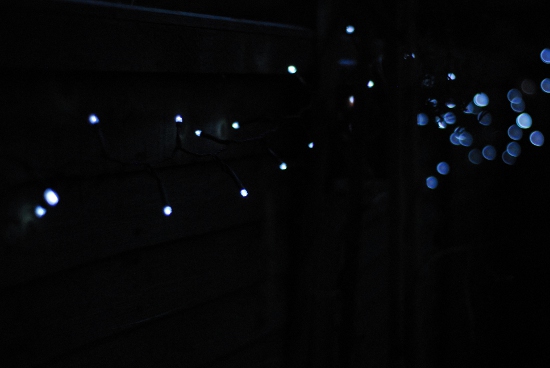
Despite the title of this post, they hardly let you garden in the dark. However, they do look good, when you look out of the kitchen windows, or stand in the middle of the garden late at night and whirl around looking at the lights and the stars.
Coincidentally, since I first drafted this entry – last week after we first put the lights up – I’ve read something else on night gardens: a post by Bristol-based gardening writer Lia Leendertz on the BBC gardening blog, about designing your garden to make it a pleasant place to spend a winter evening. Sadly we don’t have room for hedges or a fire pit, but I do like the idea of a telescope. Maybe I can make do with an SLR, my longest lens, and every teleconverter I can lay my hands on attached. Actually gardening at night will be a harder project to get going.
dark, darkness, fairy light, lighting, night, season, winter
Posted in Garden Diary, Photobloggery, The Old Garden In Bristol on Sunday, November 13th 2011 (5.04 PM).
This morning, I came across an interesting article in The Observer: for many plants and animals, spring seems to have come the wrong side of winter. Animals that should be hibernating are waking up again, and plants are still growing strongly and flowering, possibly because the weather has been unusually mild for the season. It prompted me to go outside into the garden, and have a look at the green bean plants, which we had left on their poles, just stems and pods and a few raggedy leaves, so that the beans we had left on the plant could develop and dry naturally ready for next year. Indeed, what did I find on the green beans? Lots of new buds, some of them just coming into flower. Here’s a photo I took this afternoon.
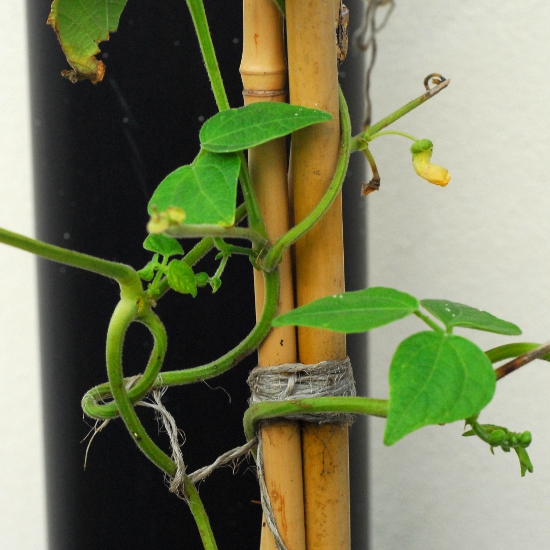
No doubt these flowers are not going to get much further; and they’re definitely not going to set fruit because we’ve not had any bees in the garden for a few weeks now. This weather doesn’t seem quite right, though.
There are a few things I did in the garden this week, largely while K was baking the Christmas cake. See, “just coming into flower” and “baking the Christmas cake” aren’t phrases that go well together at all if you’re north of the Equator. This is what got done:
- Pulling up the last of the radishes.
- Pruning some of the perennial herbs – the thymes, lavender, feverfew, and mint.
- Saving seed that is ready, or almost ready: runner beans, green beans, and coriander.
No doubt I am doing all this at entirely the wrong time of year, but – as far as the pruning was concerned, anyway – it felt like the right time to do it. The beans are for sowing next year; the coriander seeds are probably for the spice cupboard, and the pruned thyme branches were saved for the oven too.
autumn, bean, climate change, coriander, feverfew, green bean, lavender, mint, pruning, radish, runner bean, saving seed, season, seed, thyme
Posted in Practicalities, The Old Garden In Bristol on Sunday, October 30th 2011 (8.50 PM).
As I think I mentioned a while ago, shortly after we moved into Symbolic Towers we noticed a vinelike plant spreading itself rapidly over the garden trellis. None there at all when we moved in, but within a couple of months the trellis was covered. Bindweed. It seems to be endemic in this part of Bristol: you can’t go anywhere this time of year without seeing its foliage and its white trumpets clogging up fences and doing their best to strangle other plants, particularly in semi-wild areas like the edges of railway lines. We’ve spent a lot of time tracing every stalk, and digging up every little bit of bindweek rhizome we could find; carefully, like archaeologists, to make sure we didn’t break the rhizomes up or leave fragments behind. It has mostly worked: a few stems have come back, but only a few, none of them very strong. On those, we tried a method we heard on Gardeners’ Question Time: singing and blackening the leaves. It worked, too, sort of, although (of course) not as effectively as physical removal.
I was aware, of course, that things could have been far, far worse. Moreover, I was reminded by a news story K came across, about Japanese knotweed. It reminded me of the advice I read in (I think) an Alys Fowler book: if you have knotweed, move house. There are knotweed-infested places in Bristol – Arno’s Vale cemetery, for one, and some parts of the riverbank in St Philips – and, if we visit any, we are always extremely careful not to go near the stuff. Over-careful, maybe, but it’s not something we could exactly risk.
bindweed, bristol, japanese knotweed, perennial weed, weed, weeding
Posted in Retrospective, The Old Garden In Bristol on Sunday, October 16th 2011 (9.05 AM).
This post is, unfortunately, going to be rather low on photos compared to those previous, because plants that aren’t growing well, are dying off or somehow going wrong, aren’t really inviting subjects for the camera. I’ve resisted the temptation, though, to title it “Failures”, because all of these plants gave something to the garden, even if it was just a clump of foliage or something for the local caterpillars to eat.
Pattypan squash: this is an example of why you should be careful what plants you let into your garden. We decided we wanted a pattypan squash plant: they can look rather attractive, and we always use plenty of squash in cooking. By the time we decided we wanted one, though, it was definitely a bit late in the season to be growing one from seed. We went down to one of the local garden centres; all the pattypans they had looked to have signs of mildew on their leaves. We bought the best we could find, but the signs of mildew did indeed turn into worse mildew. It fruited, but its fruits were hardly an inch across. Of course, I’ve heard since, this year has been a bad year for squashes, but I’m sure that a healthier plant would have had a better chance of success.
Dill: We love dill, particularly with salmon in the Scandinavian style, so dill had to be a must for the garden. We planted plenty of dill seeds, and they sprung right up, right away. But then they didn’t stop springing. Every dill plant we grew turned into a tall, spindly thing, four or five feet high but with barely any usable foliage. Pinching out the tips didn’t seem to help.
Spring onions: these we grew from seed, and they started out well. They seemed to be taking a while, but we weren’t too worried, having picked a variety with a low chance of bolting. Then, though, a period of hot weather followed by heavy rain ruined the majority of the plants, snapping the stems. A handful have grown back from that, but neither those nor the ones which avoided the rain in the first place have really reached a harvestable thickness.
Sweet peas: the idea with these was: companion plants around our green beans. The problem with them was: they grew too well. They grew around the beans, over them, taller than them, almost swallowing them up. And then didn’t even flower. The problem, maybe, is that sweet peas aren’t bred to grow in vegetable-quality compost, which is possibly an issue with any companion planting scheme that involves decorative and produce plants mixed in together.
Japanese saltwort: we spotted this in one of the local garden centres, the excellent Riverside co-operative. We bought it because it was intriguing, and unusual. It grew, grew well. The problem, though was that we didn’t really know what to do with it; and its heart quickly became dead and woody, the living parts straggling over the edge of its pot. I have the feeling it is one of those plants which, if not kept in a container, could easily take over an entire garden.
What to learn from all this? Well, next year, we’ll definitely be keeping our spring onions rather more sheltered. We’re on the hunt, too, for a different variety of dill to try. The most important thing to remember, though: however much we want a particular variety of plant in the garden, only let it come in if it’s healthy.
dill, japanese saltwort, pattypan squash, saltwort, scallion, spring onion, squash, sweet pea
Posted in Retrospective, The Old Garden In Bristol on Saturday, October 1st 2011 (11.10 AM).
The list, in the previous post, of plants we’ve grown this year wasn’t really in any particular order; just off the top of my head as I cast my mind around the garden. Here, though, are some of the plants that we can say were a success.
Potatoes: probably our biggest success, grown in a dustbin with holes drilled in the bottom. We grew them in a mixture of soil and compost, at first, earthing up regularly with compost until it reached the top of the bin. I was expecting flowers and fruit, which we didn’t get; and we were rather worried about a leafhopper infestation which developed, damaging the leaves quite a bit. When the foliage died back, though, we upended the bin and found a healthy crop, about 600g per seed. Next year, we hope to have room for a couple more bins.
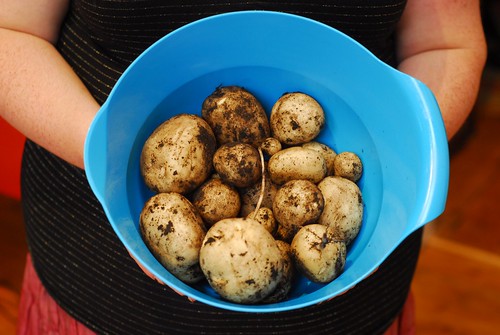
Peas: we bought small plants from the garden centre, planted them up in wine boxes, and put them on top of the garden wall, trained up the latticework. Again, each plant gave us a plentiful harvest; but we did have a bit of a mildew problem, probably caused by planting too many in each box.
French marigolds: we didn’t manage to eat any, but the plants themselves have gone happily on producing flowers all summer. They’re still in flower now, with more buds on the way.
Swiss chard: we planted this in a variety of containers, and tried harvesting and eating it at a variety of stages, from baby leaves to fully-grown leaves and stems. All of them worked pretty well: the baby leaves were ready fairly fast, and harvesting most of those left room for a few plants to grow into adulthood. Moreover, what we weren’t expecting was that we would be able to treat the adult plants in a cut-and-come-again fashion; we thought we’d harvested everything we could a few weeks back, but we now have healthy and harvestable leaves waiting for us again.
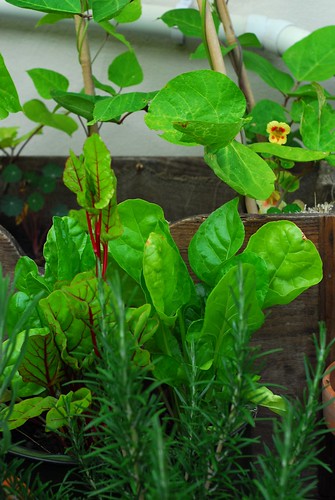
Mint: it grew, despite the best attempts of leaf-miners and caterpillars to eat it. Moreover, we kept forgetting we had mint leaves to use, leaving the mint bush to get rather overgrown and straggly; giving it a fierce trim rather more often would have left us with a healthier plant.
Feverfew: it grew very well, with attractive clusters of daisy-like flowers that have lasted well all summer. Now, we just have to work out what else it might be useful for.
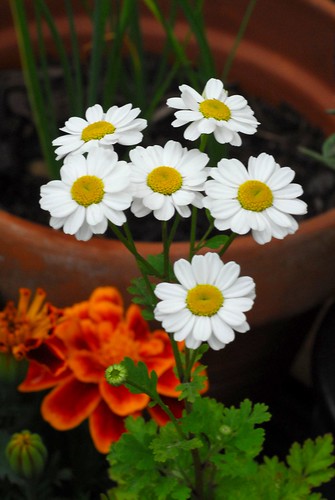
calendula, feverfew, french marigold, marigold, mint, pea, pentland early, potato, review, swiss chard
Posted in Retrospective, The Old Garden In Bristol on Tuesday, September 27th 2011 (6.29 PM).
Before we start to plan what will be going where next year, I thought it would be worthwhile putting together a brief list of what we’ve done this year, and how well it worked. And, when it’s all written down on a page, it does look like we’ve managed an awful lot. In 2011, we have grown:
- First early potatoes
- Peas
- English marigolds
- French marigolds
- Sweet peas
- Beetroot
- Spring onions
- Carrots
- Swiss chard
- Japanese saltwort
- Radishes
- Pattypan squash
- Wild Rocket
- Violas
- Marjoram
- Mint
- Basil mint
- Basil
- Runner beans
- Green beans
- Nasturtiums
- Thyme
- Feverfew
- Camomile
- Sage
- Curled parsley
- Flat parsley
- Chives
- Dill
- Coriander
- Salad leaves
- Lavender
Yes. A long list. Some of it worked, some didn’t, and an awful lot can be filed under “sort of worked, but we could have done better”. All of these things were planted in various sizes of container around the garden, nothing in the back bed at all, because we are still digging it up in an attempt to root out all the broken glass and make it safe to dib holes in with our fingers. I will, in the next few posts, break down the unmanageable list above into successes, disasters, and the catch-all “somewhere in between”.
list, review

